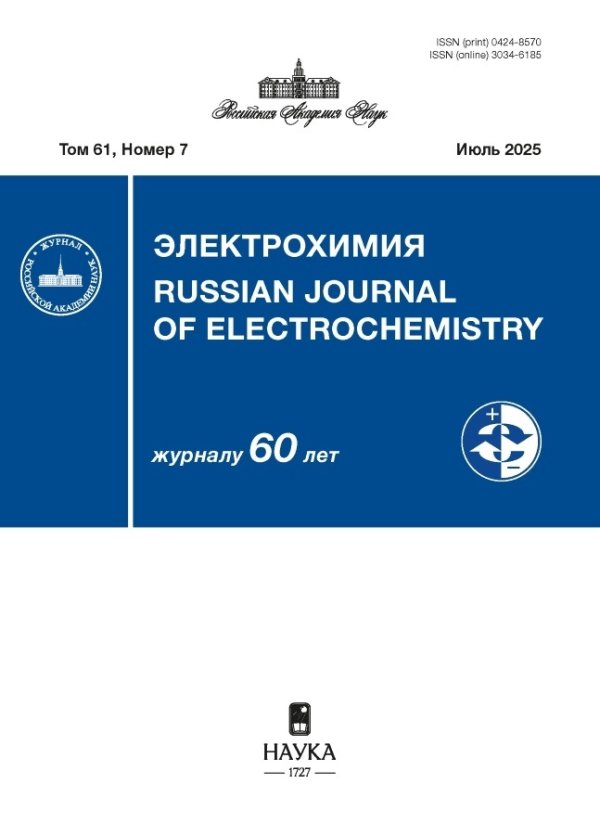Comparative Study of Biocatalytic Oxidation of Some Organic Substrates Using Shewanella xiamenensis and Escherichia coli Microorganisms on Mediator and Non-Mediator Bioanodes
- Authors: Kazarinov I.A.1, Meshcheryakova M.O.1
-
Affiliations:
- Saratov State University
- Issue: Vol 59, No 2 (2023)
- Pages: 92-100
- Section: Articles
- URL: https://rjsvd.com/0424-8570/article/view/671124
- DOI: https://doi.org/10.31857/S0424857023020044
- EDN: https://elibrary.ru/NEKTJN
- ID: 671124
Cite item
Abstract
In the work, a comparative assessment of the effectiveness of Shewanella xiamenensis and Escherichia coli microorganisms used as a biocatalyst in the process of bioelectrochemical oxidation of various substrates in neutral media on mediator-free and mediator bioanodes was carried out. It was shown that the rate of bioelectrochemical oxidation of the studied organic substrates (citric acid, glucose, sucrose) with the help of S. xiamenensis cells does not depend on the concentration of the mediator introduced into the system (methylene blue)—electron transfer from cells to the electrode occurs as a result of direct contact of cells with the electrode’s surface. A comparative kinetic analysis showed that S. xiamenensis cells are a less effective biological catalyst for the process of glucose oxidation compared to the E. coli microorganism (in the presence of a mediator). The kinetic characteristics of the glucose oxidation reaction in the “mediator–substrate–E. coli cells” system were determined. It was found that the order of the oxidation reaction with respect to glucose at the anode is equal to one, the rate constant of this reaction is 0.0214 min–1, and the half-life of glucose is 33 min. It is shown that the model system under study makes it possible to lower the concentration of glucose in the working solution to the value of the background current, which indicates an almost complete purification of the solution from the organic substrate. It is shown that in solving practical problems in order to increase the efficiency of wastewater treatment from organic substances using mediator-free bioanodes, it is necessary to search for new cells, including other cells of the Shewanella genus, with mandatory immobilization of cells on the electrode surface in order to increase electrical contact.
About the authors
I. A. Kazarinov
Saratov State University
Email: kazarinovia@mail.ru
Saratov, 410012 Russia
M. O. Meshcheryakova
Saratov State University
Author for correspondence.
Email: kazarinovia@mail.ru
Saratov, 410012 Russia
References
- Logan, E. and Rabaey, K., Conversion of Wastes into Bioelectricity and Chemicals by Using Microbial Electrochemical Technologies, Science, 2012, vol. 337, p. 686.
- Angenent, L.T., Karim, K., Al-Dahhan, M.H., Wrenn, B.A., and Domiguez-Espinosa, R. Production of bioenergy and biochemicals from industrial and agricultural wastewater, TRENDS in Biotechnology, 2004, vol. 22, no. 9, p. 478.
- Казаринов, И.А. Введение в биологическую электрохимию. Саратов: Изд-во Сарат. ун-та, 2012. 216 с. [Kazarinov, I.A., Introduction to biological electrochemistry (in Russian), Saratov: Izd-vo Sarat. un-ta, 2011. 216 p.]
- Katz, E., Shipway, A.N., and Willner, I., Handbook of fuel cells – Fundamentals, Technology and Application, Vielstich, W., Gasteiger, H.A., and Lamm, A., Eds, London: John Wiley&Sons. Ltd., 2003, vol. 1, p. 2–27.
- Shukla, A.K., Suresh, P., Berchmans, S., and Rajendran, A., Biological fuel cells and their applications, Current Science, 2004, vol. 87, no. 4, p. 455.
- Davila, D., Esquivel, J., and Vigues, N., Development and Optimization of Microbial Fuel Cells, J. New Mater. Electroch. Systems, 2008, vol. 11, p. 99.
- Bulter, J.I., A diheme c-type cytochrome involved in Fe(III) reduction by Geobacter sulfurreducens, J. Bacteriol, 2004, vol. 186, p. 4042.
- Methe, B.A., Genome of Geobacter sulfurreducens: metal reduction in subsurface environments, Science, 2003, vol. 302, p. 1967.
- Rabaey, K., Microbial ecology meets electrochemistry: electricity driven and driving communities, ISME J., 2007, vol. 1, p. 9.
- Lovley, D.R., Microbial energizers: fuel cells that keep on going, Microbe, 2006, vol. 1, p. 323.
- Myers, C.R., Localization of cytochromes to the outer membrane of anaerobically grown Shewanella putrefaciens MR-1, J. Bacteriol, 1992, vol. 194, p. 3429.
- Myers, C.R., Role of outer membrane cytochromes OmcA and OmcB of Shewanella putrefaciens MR-1 in reduction of manganese dioxide, Appl. Environ. Biotechnol., 2001, vol. 67, p. 260.
- Kim, H.J., A mediator-less microbial fuel cell using a metal reducing bacterium Shewanella putrefaciens, Enzyme Microb. Technol., 2002, vol. 30, p. 145.
- Kim, B.H., Direct electrode reaction of Fe(III)-reducing bacterium Shewanella putrefaciens, J. Microbiol. Biotechnol., 1999, vol. 9, p. 127.
- Градсков, Д.А., Игнатов, В.В., Казаринов, И.А. Биоэлектрохимическое окисление глюкозы с помощью бактерии Escherichia coli. Электрохимия. 2001. Т. 37. С.1397. [Gradskov, D.A., Ignatov, V.V., and Kazarinov, I.A., Bioelectrochemical oxidation of glucose using the bacterium Escherichia coli, Russ. J. Electrochem., 2001, vol. 37, p. 1216.]
- Кузьмичева, Е.В., Степанов, А.Н., Казаринов, И.А., Игнатов, О.В. Изучение кинетики окисления глюкозы бактериальными клетками Escherichia coli с помощью метода вращающегося дискового электрода. Электрохим. энергетика. 2007. Т. 7. С. 200. [Kuzmicheva, E.V., Stepanov, A.N., Kazarinov, I.A., and Ignatov, O.V., Study of the kinetics of glucose oxidation by Escherichia coli bacterial cells using the rotating disk electrode method, Elektrokhimicheskaya energetika (in Russian), 2007, vol. 7, p. 200.]
- Казаринов, И.А., Кузьмичева, Е.В., Игнатова, А.А. Оценка эффективности работы экзогенных редокс медиаторов в биоэлектрохимической системе глюкоза-клетки Esherichia coli-медиатор. Электрохим. энергетика. 2011. Т. 11. С. 60. [Kazarinov, I.A., Kuzmicheva, E.V., and Ignatova, A.A., Evaluation of the efficiency of exogenous redox mediators in the bioelectrochemical system glucose-cells Escherichia coli-mediator, Elektrokhimicheskaya energetika (in Russian), 2011, vol. 11, p. 60.]
- Казаринов, И.А., Игнатова, А.А., Наумова, М.Н. Кинетика электрокаталитического окисления глюкозы клетками бактерий Escherichia coli в присутствии экзогенных медиаторов. Электрохимия. 2014. Т. 50. С. 97. [Kazarinov, I.A., Ignatova, A.A., and Naumova, M.N., Kinetics of the electrocatalytic oxidation of glucose by Escherichia coli bacterial cells in the presence of exogenous mediators, Russ. J. Electrochem., 2014, vol. 50, p. 87.]
Supplementary files



















